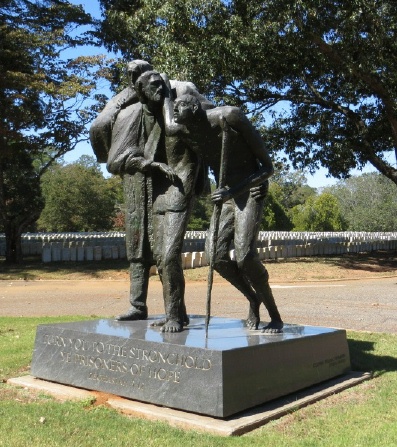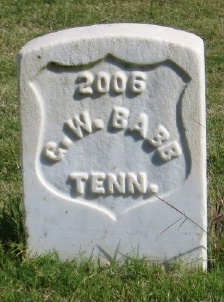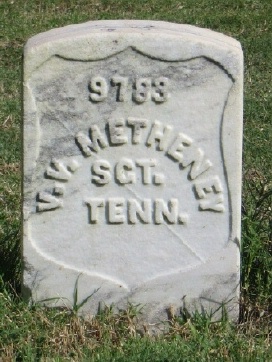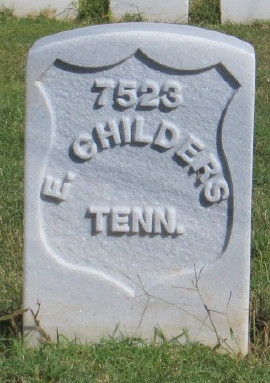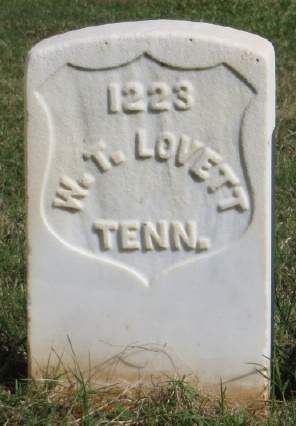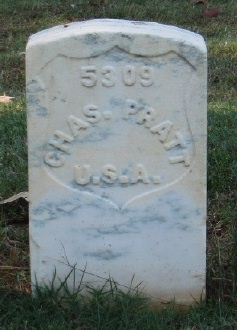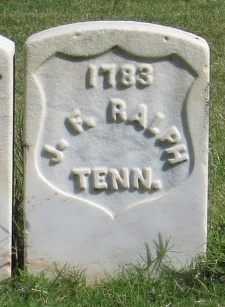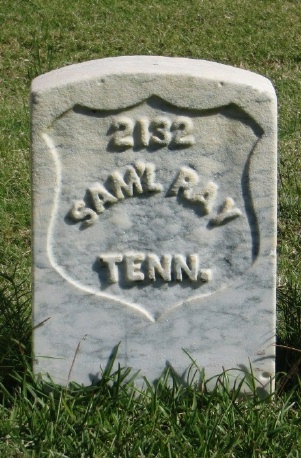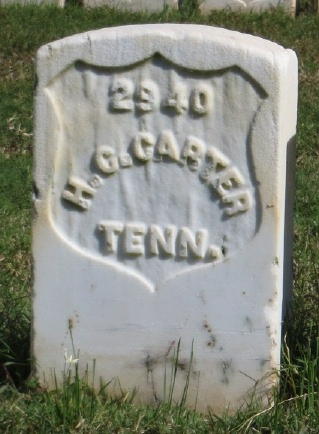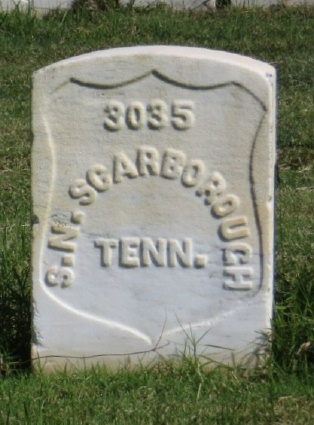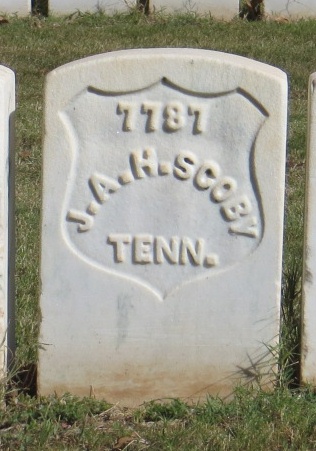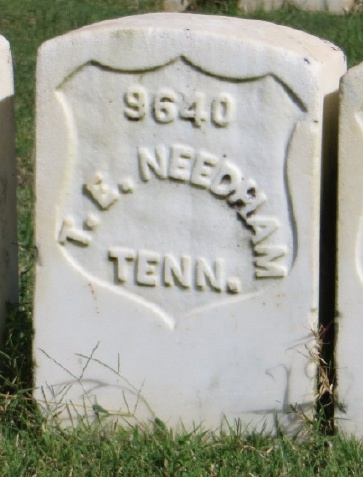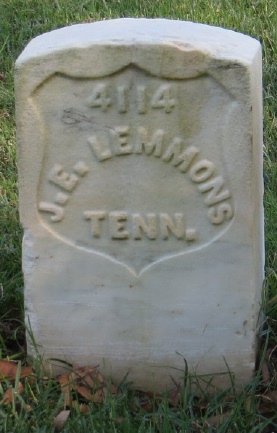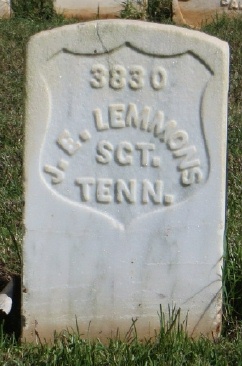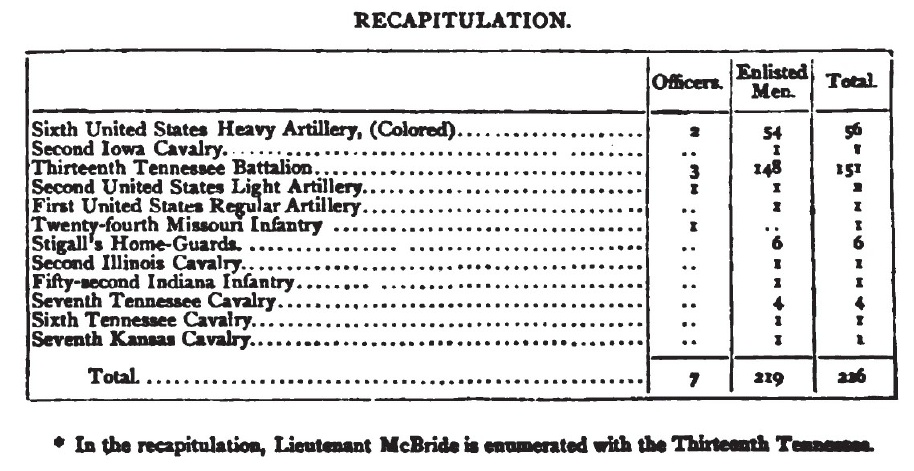Stories of Union Combatants
The following are details about some of the Union soldiers who were at
Fort Pillow.
The officers are listed first followed by
stories of some of the enlisted men.
 Click on this icon to view NARA record for
soldier. Click on this icon to view NARA record for
soldier.
Major
William
Bradford was acting commander of the fort
after Major Booth was killed by a sniper. When the fort fell,
Major
Bradford fled and jumped into the Mississippi River in an attempt to
escape. The Confederates fired volleys at him but missed.
He was
retrieved out of the water and then tried to run up the bluff.
Again,
volleys were fired at him and he was taken prisoner without any
injuries. During the night he escaped from the Confederate
Officer's
tent. He was re-captured and one version is that he was shot
trying to
evade capture and the other story is he was executed. Major
Bradford grew up in Tennessee not very far from General Nathan
Forrest's childhood home. They were neighbors.
Captain Theodore
Bradford, brother
to Major Bradford, was acting as signal officer and attempted to signal
the gunboats for help. As the Confederate assault over-ran the fort,
they saw him on a ridge signalling. One account said he shot 3
Confederates as they attempted to capture him. An order was given
to kill the officer and the advacing soldiers fired a volley. He
was said to have been shot to pieces by this volley.
 Captain Charles J. Epeneter and
his mess mate, Lt. Peter Bischoff,
both had transferred from the 1st Missouri Light Artillery so they
could obtain Officer commissions in Company A of the 6 USC Heavy
Artillery. Capt. Epeneter was manning the #4 gun when a ball
fractured his head. Lt. Bischoff continued to fight and when
Major Bradford yelled for everyone "Save yourself", Lt. Bischoff stayed
and tried to
rally the troops. Capt. Epeneter was taken as a prisoner despite his head
wound. Lt. Bischoff survived and was transported with Captain
Young to the prison camp. Captain Epeneter escaped from a
captivity
in Charleson SC and returned to his unit on Nov. 4, 1864. Captain Charles J. Epeneter and
his mess mate, Lt. Peter Bischoff,
both had transferred from the 1st Missouri Light Artillery so they
could obtain Officer commissions in Company A of the 6 USC Heavy
Artillery. Capt. Epeneter was manning the #4 gun when a ball
fractured his head. Lt. Bischoff continued to fight and when
Major Bradford yelled for everyone "Save yourself", Lt. Bischoff stayed
and tried to
rally the troops. Capt. Epeneter was taken as a prisoner despite his head
wound. Lt. Bischoff survived and was transported with Captain
Young to the prison camp. Captain Epeneter escaped from a
captivity
in Charleson SC and returned to his unit on Nov. 4, 1864.
Surgeon
Charles
Fitch - Charles
Fitch was the Surgeon for the fort. He previously served as an
Assistant Surgeon for the 4th Iowa Cavalry. He
rendered aid to the wounded down below the bluff. He was also
present to give aid after the battle had ended. He testified for
the Congressional Investigation while recovering at his home in Iowa
but some did not think his statment supported their agenda.
 Captain John T.Young was one of the few officers to
have survived. He was a on the rolls with the 24th Missouri Infantry
but was assigned to Fort Pillow as Provst
Marshall. During the battle, he was a member of the team
that met for the truce, along with Lt. Leming and Captain Theodore
Bradford. After the battle, General Forrest’s aid selected
Captain Young from the group of prisoners to help him negotiate a truce
with the Union gunboats and transfer the wounded to the steamer “Platte
Valley”. Captain Young was first taken to Andersonville Prison
but was later seperated, as the Confederates tried force him to sign
papers denouncing the massacre. After the war, he was a school
teacher in Missouri and died in Los Angeles in 1915.. Captain John T.Young was one of the few officers to
have survived. He was a on the rolls with the 24th Missouri Infantry
but was assigned to Fort Pillow as Provst
Marshall. During the battle, he was a member of the team
that met for the truce, along with Lt. Leming and Captain Theodore
Bradford. After the battle, General Forrest’s aid selected
Captain Young from the group of prisoners to help him negotiate a truce
with the Union gunboats and transfer the wounded to the steamer “Platte
Valley”. Captain Young was first taken to Andersonville Prison
but was later seperated, as the Confederates tried force him to sign
papers denouncing the massacre. After the war, he was a school
teacher in Missouri and died in Los Angeles in 1915..
Lieutenant Mack
J. Leming was the Adjutant with 13th US
Tennessee Cavalry. His name is recorded in different books and
sources by various spellings: Lemming, Leaming, Learning, and even
Seaming. Lt. Leming testified to the Congressional investigation
that he was shot at 15 paces after surrendering. A Confederate
who was a fellow Mason removed him from the field and placed him in one
of the make-shift hospitals. He testified several colored troops
were killed before the wounded were moved to the steamboat. His
previous service was as a private in 72nd Illinois Infantry Regiment.
Lieutenant John
C. Akerstrom was
the QuarterMaster
Officer and a member of Company E, 13th US Tennessee Cavalry. Lt.
Akerstrom was severly wounded. It seems the Confederates had a special
grudge against Lt. Akerstrom. Eye witness reports in the OR's
and Congressional Investigation state Lt. Akerstrom was nailed to the
side of one of the houses and it was set on fire. There were various
accounts and descriptions of how he was found.
 Lt.
Cordy Revelle had
previously served in Hurst's 6th Tennessee
Cavalry(US). When
he joined the 13 Tenn Cavalry, he was elected as an officer.
Cordy’s two brothers, Hardy Revelle
and Axum Revelle, had served
in
Duckworth's 7 Tennessee Cavalry(CS) earlier in the war. Both
completed their required service or had deserted. Hardy Revelle was a clerk in the
town. Lt. Cordy Revelle was also described as a clerk for the
Army post. During the battle, Hardy
fought with the soldiers. He survived the battle and
was released. However, Lt. Cordy Revelle was killed, most likely
after the fort fell. Another interesting connection is that their
sister had married into a family who owned 400 acres in Fulton, just
south of the fort. This all seems to support the theory that Fort
Pillow was used to transport stolen and black market goods. Hardy wrote a letter from Fort
Pillow the day before the attack. Lt.
Cordy Revelle had
previously served in Hurst's 6th Tennessee
Cavalry(US). When
he joined the 13 Tenn Cavalry, he was elected as an officer.
Cordy’s two brothers, Hardy Revelle
and Axum Revelle, had served
in
Duckworth's 7 Tennessee Cavalry(CS) earlier in the war. Both
completed their required service or had deserted. Hardy Revelle was a clerk in the
town. Lt. Cordy Revelle was also described as a clerk for the
Army post. During the battle, Hardy
fought with the soldiers. He survived the battle and
was released. However, Lt. Cordy Revelle was killed, most likely
after the fort fell. Another interesting connection is that their
sister had married into a family who owned 400 acres in Fulton, just
south of the fort. This all seems to support the theory that Fort
Pillow was used to transport stolen and black market goods. Hardy wrote a letter from Fort
Pillow the day before the attack.
 Hardy Revelle's records in
Confederate cavalry. Store Clerk and armed civilian. Hardy Revelle's records in
Confederate cavalry. Store Clerk and armed civilian.
 Axum Revelle's records in
Confederate cavlry. Not present. Axum Revelle's records in
Confederate cavlry. Not present.
William
(Billy) R. Nail of
Company E, 13 Tennessee Cavalry had the misfortune of
being captured
by the 16th Tennesse Cavalry(CS) regiment from which he had deserted.
His name appears on the role of prisoners but there is
no record of him enrolled into any prison camp. Either he died of
his wounds enroute to the prison camps or his former comrades executed
him as a deserter. (Source: Ward)
 John W.
Long is
mentioned on page 293 of "River Run Red" as being a survivor of
Andersonville who later died when the Steamer SULTANA exploded on the
Mississippi River on April 27, 1865. The NARA files for John W.
Long of the 13 Tennessee Cavalry states he died and was buried at
Andersonville prison. There was a John Long of the 3 Tennessee
Cavalry whose NARA records and other sources prove he was the one who
died on the SULTANA
explosion. It seems that the book got the wrong soldier and
unit. There were no Fort Pillow prisoners on board the SULTANA. John W.
Long is
mentioned on page 293 of "River Run Red" as being a survivor of
Andersonville who later died when the Steamer SULTANA exploded on the
Mississippi River on April 27, 1865. The NARA files for John W.
Long of the 13 Tennessee Cavalry states he died and was buried at
Andersonville prison. There was a John Long of the 3 Tennessee
Cavalry whose NARA records and other sources prove he was the one who
died on the SULTANA
explosion. It seems that the book got the wrong soldier and
unit. There were no Fort Pillow prisoners on board the SULTANA.
George W.
Kirk of
Company A, 13 Tennessee Cavalry was one of those captured during the
battle. Ward's book, "River Run Red", says had deserted from the
11
Texas Cavalry(CS) before joining Bradford's Union cavalry.
However, the NARA records for the soldier in the 11 Texas Cavalry(CS) was not
the same person. The
NARA files show that George W. Kirk enlisted in the 13 Tennessee
Cavalry(US) in December 1863. Upon capture, he was probably sent to
Andersonville but there is no detail records on him there. One
prisoner form states he was released in North Carolina on
February 27, 1865. George Kirk died at sea in the disaster of
the steamer GENERAL LYONS, which sunk caught fire during a storm and
sunk on March 31, 1865 with the loss of 400 soldiers and paroled
prisoners.
 Jasper
Cozart of
Company E, 13th Tennessee Cavalry, enlisted on January 20,
1864. Jasper Cozart was from Crocket County but enlisted at
Union City. He had a brother, Newton, who enlisted in the
Confederate 6 Tennesse Infantry. After capture at Fort Pillow, Jasper
was taken to Newborn, SC, where he escaped and made it to the Union
lines on March 15, 1865. He moved to Texas after the war and had
a daughter. I researched this soldier as I believe he was a
relative of a friend at work who has family ties to Fayette County,
Tennessee. Jasper
Cozart of
Company E, 13th Tennessee Cavalry, enlisted on January 20,
1864. Jasper Cozart was from Crocket County but enlisted at
Union City. He had a brother, Newton, who enlisted in the
Confederate 6 Tennesse Infantry. After capture at Fort Pillow, Jasper
was taken to Newborn, SC, where he escaped and made it to the Union
lines on March 15, 1865. He moved to Texas after the war and had
a daughter. I researched this soldier as I believe he was a
relative of a friend at work who has family ties to Fayette County,
Tennessee.
Armstead Burgess
of
Company B, 6 US Colored Heavy Artillery, was one of the black soldiers
who survived capture. In August 1863, he enlisted into the 1st
Alabama Siege Artillery(African Descent) in Corinth. He was from
Franklin, Alabama, as were many blacks who joined this unit. This unit
was redisgnated the 6USCHA. During the battle, Private Burgess
was struck in the head and when he woke he was a prisoner. He was
among 20 black prisoners who were returned to hard labor. In
December 1865, he was sent to Richmond by train to work on defenses
there. By May 1865, he was still listed as MIA and possibly
killed. He eventually returned to his unit, now redsignated 11
USCT(new) and mustered out January 12, 1866. Burgess was a farmer
and property owner and lived in Tennessee and Arkansas. He
marrying three times and had 12 children. He died 1923 in Monroe
County, Arkansas. {Details provided by his
great-granddaughter Yulanda Burgess}
 Click to view Prisoner Form for Pvt Burgess of 11USCT issued at
Richmond.
Click to view Prisoner Form for Pvt Burgess of 11USCT issued at
Richmond.
After the battle, Daniel
Tyler of Company B, 2nd US
Colored Light Artillery, was badly
wounded and the Confederates threw him into the ditch and buried him. He
was lying near the edge and was able to dig his face out with his good
hand. By dawn of the 13th, he managed to dig himself out about the time
the gunboat “Silver Cloud” arrived. He
managed to get down to the gunboat. There
were many newspaper accounts about Tyler’s
second deliverance. Though badly wounded and almost blind, he returned
to his unit in May 1864. He
then went somewhere to recuperate and when he returned in March 1865,
he was accused of being absent without leave and was imprisoned in
Libby Prison in Memphis. Amid
the filth and deplorable conditions, he died in prison 4 months later
on July 12, 1865.
Michael
Click was mortally
wounded. His name did not appear on any rolls of the
wounded. He was thought to have died at Andersonville but
research of personal records showed that he died soon after the
battle. See Appendix B, Footnote 5 of Cimprich's book "Fort
Pillow, a Civil War Massacre, and Public Memory". A total of 16
names are listed as those whose records were lost for a period of time
after the battle.
Isaac Ledbetter of
Company E of 13 Tenn Cavalry was discharged and became a Methodist
minister and postal clerk
and had 6 childen. He was the oldest living survivor of the Union
garrison. He died in Morrilton AR in 1935.
Charles
Macklin (aka
Koon) of
Company C, 6 US Colored Heavy Artillery stood over 6 feet tall and had
a patch of white hair near his temple. His owner in Alabama named Koon
had sold him to the Macklin family in Carroll County,
Mississippi. He ran away to join the army. After the
battle, his body was easily identifiable by his height and the white
patch of hair. He was identified by his uncle, Charles Hughes who
was a black cook serving with General Forrest's
staff. (Source: Ward)
Adam,
Simon and Essex Middleton.
These three
brothers were present at the battle. They were runaway slave who
had joined Company C, 6 USCHA. Essex Middleton was
the only one of the brothers to have survived the battle. After
the battle he was identified by Capt.
William Green Middleton, who was the son of their former
master. Captain Middleton found the bodies of the other two
brothers by the river. Capt. Middleton returned Essex back to their plantation
before he himself was killed at Battle of Harrisburg. Their names
appear in the records of the reorganized 11USCT, the unit that
succeeded the 6USCHA. {See story of Capt. William Middleton in
the Confederate stories, below.}
 Sherry Blain
(aka Blane), company D, 6 USCHA, was the brother of Aaron Blaine, 6/D. He
was discharged in Jan 1866 and reclaimed his father's name, Thornton. Attached Pension
record shows his alias. Sherry Blain
(aka Blane), company D, 6 USCHA, was the brother of Aaron Blaine, 6/D. He
was discharged in Jan 1866 and reclaimed his father's name, Thornton. Attached Pension
record shows his alias.
John Hennessey He enlisted at age 21
with Company A, 113th Illinois Infantry Regiment. He transferred to the 6 US Colored Heavy Artillery where he was promoted to Sergeant-Major. Captain Smith offical
report of the battle stated that Sgt. Hennessey was murdered after the
flag of truce. However, Sgt. Hennessey escaped from the enemy and
returned to his unit at Memphis on May 20, 1865.
Lt. John Gregory - The service records
of Lt. Gregory, Co. A, 13 Tenn Cavalry, included a letter that
states he was shot and killed by Major Bradford during a confrontation
on Feb 23 1864 at Fort Pillow. He was not
killed at the
Battle. The story is that Lt. Gregory was angry when Major
Bradford selected his brother, Theodorick, to command a newly formed
company. There was a confrontation and pistols were drawn and Lt.
Gregory was killed. It seems quite amazing that an Army officer
was shot by
his own commander and there is no report of any court martial or
investigation. His story provides some insight into the
discipline of the Union cavalry during this time.
Lieut-Colonel Thomas Jackson was given command of the 6 US Colored Heavy Artillery on
March 1864. Even though he was in command of the
unit, he placed Major Booth in command of the unit in the field. After the battle,
Lt-Col. Jackson visited the Fort and became involved in the reporting
of the events, both through official Army correspondence and other
unofficial accounts. Two
stories that he circulated turned out to be questionable.
Lt-Col. Jackson developed an elaborate account of how the regimental
flag was saved by Sgt.
Eli Cothel of
Company B. The
story goes that Sgt. Cothel was wounded early in the battle and as the
fort was over-ran, he saw the regiment’s flag and took it and wrapped
it around his body, thus staining it with his own blood while trying to
rescue it. Sgt. Cothel never mentioned this account to any newspaper
nor to the Congressional
Investigation Committee for
which he was a witness. This
could not have been Sgt. Cothel, because when he was wounded in the
morning, he was taken down the bluff to the makeshift hospital and he
escaped by crawling into the brush along the river.
Lt.-Colonel
Jackson also identified Sgt. Cothel as the soldier who dug himself out
after being buried alive by the Confederates. This story is true
but the real soldier was Daniel Tyler
of Company B(see related story). Lt-Col. Jackson also
spoke highly of his troops by saying they continued fighting while
retreating down the bluffs to the safety of the gunboats. This did not match
up with the account that was portrayed by the Congressional
Investigation Committee. These
stories told by Lt.-Col. Jackson as well as many other discrepancies he
spoke about, may explain why the Committee did not include his
testimony in their report.
Lieutenant
Willialm Clary of the 13 Tennessee Cavalry was returning to
Fort Pillow onboard the gunboat Silver
Cloud and witnessed the battle. He testified to the
Congressional Committee.
William E. Johnson,
Company B, 13 Tennessee Cavalry, was also on board the Platte
Valley, but was possibly out of sight of the fort.
Transfers from
3rd Illinois Cavalry
Three
of the officers transferred from the 3rd Illinois Cavalry into the 6 US
Colored Heavy Artillery.
|
 Captain
Delos Carson, Company D, 6 USCHA. Captain
Carson
was in command of Company D during the battle. Private Fran Hogan
witnessed Captain Carson
shot
after the surrender. His previous service was a private in the 3rd Illinois
Cavalry. Many white soldiers jumped at the opportunity to
join a colored regiment so they could get a quick promotion. Captain
Delos Carson, Company D, 6 USCHA. Captain
Carson
was in command of Company D during the battle. Private Fran Hogan
witnessed Captain Carson
shot
after the surrender. His previous service was a private in the 3rd Illinois
Cavalry. Many white soldiers jumped at the opportunity to
join a colored regiment so they could get a quick promotion.
|
Lt.
Daniel Van Horn, Company D,
6 USCHA. Lt. Van Horn was
slightly wounded. He changed clothes and escaped capture.
He wrote a report of the battle and accounted for the officer
casualties. His report was published in the Joint Committee
Report.
|
 1st Sergeant Melville
Jenks, Company
D,
6 USCHA. This name
was mentioned in some OR's but he was not mentioned
in Ward's book and many other sources. His records say he was a
1st
Sergeant in Company D. His NARA
records describes him as "florid" or reddish, which means he was not a
black man. His records state he was wounded and also taken
prisoner. His death certificate specifically stated that he
died at Andersonville but there is no record of him being a prisoner
there or even buried there. None of the soldiers from the 6 US
Colored Heavy Artillery, neither
black or white, were sent to Andersonville.
1st Sergeant Melville
Jenks, Company
D,
6 USCHA. This name
was mentioned in some OR's but he was not mentioned
in Ward's book and many other sources. His records say he was a
1st
Sergeant in Company D. His NARA
records describes him as "florid" or reddish, which means he was not a
black man. His records state he was wounded and also taken
prisoner. His death certificate specifically stated that he
died at Andersonville but there is no record of him being a prisoner
there or even buried there. None of the soldiers from the 6 US
Colored Heavy Artillery, neither
black or white, were sent to Andersonville.
Further research of his records show that he enlised in the 3rd
Illinois Cavalry and served in Company I with Delos Carson and Daniel
Van Horn. He joined the 6USCHA at Corinth on 25
November 1863
by Lt. Meagher. It appears the artillery unit was still
forming at this time--- and only 4 months before the Battle of Fort
Pillow.
The newspaper article, below, tells what happened to 1st Sgt.
Melville Jenks and Captain Carson.
|
This
is an article
from the The
New York Herald Tribune, dated May 2, 1864.
Remember this
is a newspaper account and sometimes they got it wrong.
"The
captain of Company C was on leave of absence at Memphis, consequently
he is safe. The first lieutenant, Company C, John D. Hill, was killed
early in the morning. The second lieutenant, Company C, F. McClure, is
wounded and prisoner. The captain of Company D, Delos Carson, was
taken prisoner, as far as we have heard, and was shot two miles out
from Fort Pillow, because he acknowledged to be a captain of a colored
company.
The 1st
Sergeant of Company D, Melville Jenks, was shot while bearing a
flag of truce to the Rebels, in token of his and his squad of men's
surrender. He had got nearly up to them before they fired on him, then
they murdered the squad of men that had thrown down their arms. The
whole number killed will exceed 250; all but about 75 or 100 were
murdered in cold blood after they were overpowered. They never
surrendered, as has been published, but were taken by storm, fighting
until completely crowded out of the little fort by the Rebels coming
in."
(Source Webpage:
http://millikensbend.org/articles-docs/new-york-tribune/nyt-01-007.html
)
Note:
the article does not
say
Sgt Jenks was killed---only shot.
|
---o---
|

